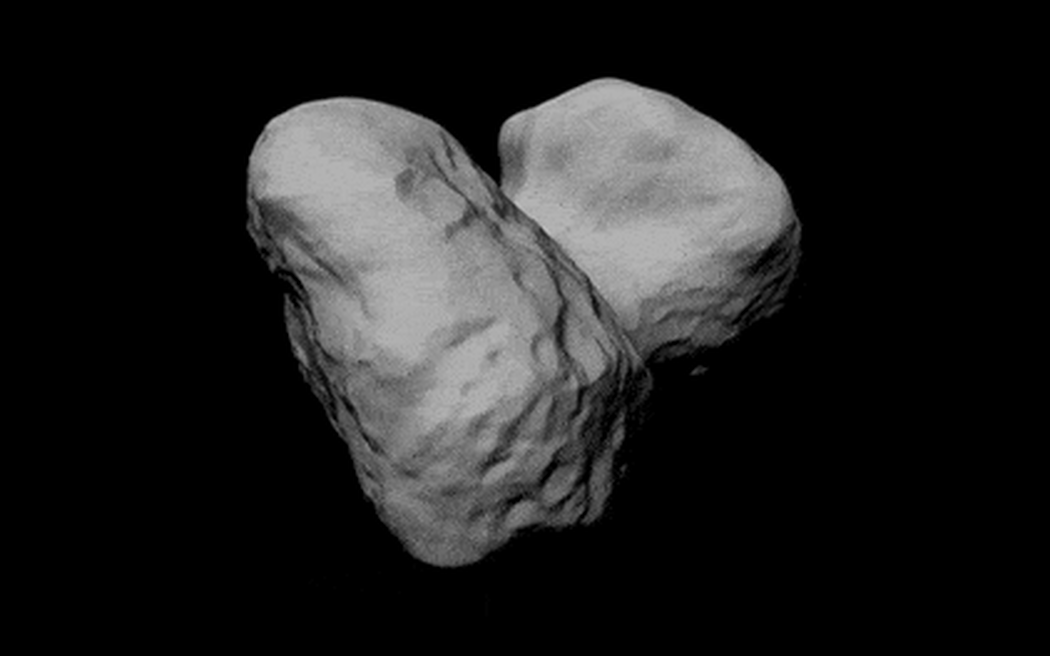The rubber duck-shaped comet being followed by Europe's Rosetta probe used to be two separate objects.

A full rotation of the comet's body takes just over 12.4 hours. Photo: Supplied/ESA
Scientists say pictures of 67P show its two lobes to have "onion skin" layers that intersect in a way that can only be the result of two different bodies having collided and stuck together.
Ever since Rosetta arrived at the comet, the origin of its bizarre form has been one of the major puzzles.
The solution is now due to be published in the journal Nature.
Mission team members have also held a media conference to give further details, at the European Planetary Science Congress in Nantes, France.
Rosetta first spied the duck on approach to 67P/Churyumov-Gerasimenko in July 2014.
The idea that it was a "contact binary" - two conjoined comets - was a popular explanation from the word go.
But proving it has not been straightforward. An alternative possibility is simply that the icy dirt ball has been sculpted this way.
Every time it comes around the Sun, 67P's ices warm and it throws off gas and dust, and it could have been that this process has dominated in just one region to produce the distinctive appearance.
The Osiris camera on Rosetta can now settle the debate.
It reveals layers up to 650m thick in the body of the duck that are independent of similar strata detected in its head.
Additional measurements by Rosetta of variations in the local tug of gravity across the lobes also support this two-body origin.
The direction of the tugging is more closely aligned with the independent layering than with a centre of mass associated with a single object.
Union of onions
Scientists say that to collide and stick together, the impact must have been a very low velocity one - perhaps just a few metres per second. Any faster, and the primary objects would have done enormous damage to each other.
"I would say it's a quite beautiful love story," Matteo Massironi, from the Osiris team, said at Monday's press briefing.
He said a key piece of evidence was a series of cross-sections of the comet, which the team were able to construct by extending the layers glimpsed on the surface into a 3D model of 67P's interior. These cross-sections painted a clear picture of two distinct sets of layers, reminiscent of a pair of onions.
"You don't know the structure of an onion until you cut across it," Dr Massironi said. "What we have seen is that this stratification is really continuous - and that [the one in the tail] doesn't match that of the head."
The discovery's consequences for what we understand about comet formation could be quite profound, says team member Stephen Lowry from Kent University, UK.
"It shows that comets were forming into large sizes and that they were then still colliding in this grown form to make even larger comets. So, it's not simply a case of independent comets completely forming out of centimetre- or metre-sized planetesimals, to make the comets we see today. And that's really quite fascinating, because it could be quite a ubiquitous process."
Other comets seen at relatively close quarters also display lobed shapes, including comets Halley, Borrelly and Hartley-2. Could they also be the result of the low-velocity bump-and-stick events?
The tantalising prospect now is whether what was once two objects could split into two again. Could the constant erosion of gas and dust result in the duck losing its head? And will Rosetta be on hand to witness it?
The European Space Agency (Esa) probe has pictured a crack in the neck region of 67P, says Dr Lowry.
"If a comet is going to split, it's most likely to break along the interface between the two lobes. But I haven't seen any evidence yet that the crack is getting longer or wider. That's a strong indicator to me that perhaps 67P won't split on this orbit of the Sun."
The comet takes just over six years to orbit the Sun and the Rosetta mission, after receiving a 10-month extension, will nonetheless end in September 2016.
At that point the spacecraft will spiral gradually closer and land yet again on 67P, said Esa project scientist Matt Taylor at the press conference - making a reference to the Philae lander's bumpy touchdown in November 2014.
He added that although the comet has passed its "perihelion" (its closest approach to the Sun), the mission has really only just begun. "The papers are starting to flow."'
- BBC

